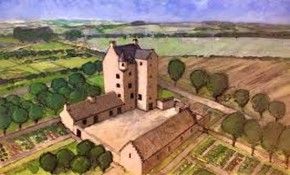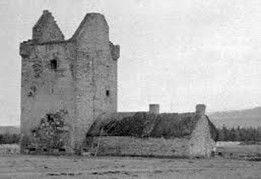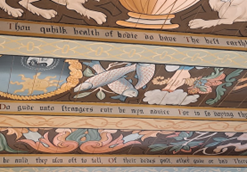Fairburn Tower
Fairburn Tower was built around 1545 by Murdoch Mackenzie. As a boy, he and his brothers were sent to Court in the 1530s. He became a royal favourite and ‘Groom of the Bedchamber’ to King James V.
Murdoch became tenant of the royal lands at Fairburn in 1539. He was later gifted the lands on condition he build a dwelling and cultivate the land. Stewart kings used land grants to win the loyalty of quarrelsome clans. In this way, Mackenzie’s increased their power across Ross-shire and the Black Isle. Lying between the rivers Conon and Orrin, with views to the Beauly Firth, Fairburn was an ideal lookout post in a chain of Mackenzie castles and tower houses. It was also a favoured drovers crossing across the Orrin to the livestock markets of Muir of Ord and generated regular income.
Building of the Castle
A typical, four-storey tower house, Fairburn was built for defence and comfort. The cellar still has its gunports and a swivel mount for a gun pintle. Windows were small and the main entrance to the 1st floor (today’s kitchen) was by an external stair, probably timber. Two upper floors (the hall and laird’s private chamber) were reached by narrow intramural stairs, and the walls were peppered with alcoves and closets in typical Jacobean style.
The Castle passes through many hands
When James V died in 1542, Murdoch returned to Fairburn. Within 50 years of its creation a stair turret had been added, the roof garret became an extra storey, and later, a single storey dining hall was added adjacent to the tower.
The Mackenzies of Fairburn prospered until the Jacobite uprising of 1715 when Roderick, 7th Laird, fought with the Jacobites. He forfeited his lands after their defeat but regained his title in 1731 - but family fortunes never fully recovered.
When the Young Pretender ‘Bonnie Prince Charlie’ rose in 1745, the 9th Laird, Alexander, declined to rise for either side. He said ‘a farmer or grasier is all I pretend to’. And yet, it is said his wife, Barbara Gordon, sold her jewels for the Jacobite cause! When he died in 1760 his son was still a minor and, sadly, grew up to be a spendthrift. By 1759 Fairburn Tower was uninhabited.
General Sir Alexander Mackenzie, the 10th and last laird, was one of Wellington’s most important generals in the Peninsular Wars. He sold all the family lands, and the Tower was finally bought by industrialist, John Stirling, in 1876. He built nearby, Fairburn House, and his descendants still own the estate today.
The Brahan Seer’s Prophecy:
In the mid-17th century, the Tower was the subject of some dark prophecies by the ‘Brahan Seer’. This legendary figure, a farm labourer from Brahan Estate, was well known for having the gift of ‘second sight’. After displeasing the Lady Cromartie (a Mackenzie) with one of his “seeings”, he was burned as a witch at Chanonry Point near Fortose. Before he died, he cursed the Mackenzies and foretold:
“The day will come when the Mackenzies of Fairburn shall lose their entire possessions; their castle will become uninhabited and a cow shall give birth to a calf in the uppermost chamber of the tower”.
In 1851, the upper floors of the empty tower were used to store hay. A cow climbed to the top and gave birth in the garret, finally fulfilling The Brahan Seer’s prophecy.
Fairburn Tower’s Restoration
By the 1990’s the tower and adjacent cottages were roofless, gutted ruins with large cracks in the walls. The Stirling family approached the Landmark Trust to try to save the tower and by 2013 restoration plans were underway. The main tower, and stair turret were basically sound despite cracks, and building analysis and archaeology increased understanding of the building. Cobbled surfaces around the tower had also formed the footings for surrounding stables, buildings and crofts.
Completed in 2022, the restoration included a new roof and extensive repairs to masonry, stairs, bartizans, roofs, doors and windows. Electricity was provided using solar panels, drainage by soakaway, and a new concrete stair was installed. In Murdoch’s original Hall, the artist Paul Mowbray created a stunning, painted ceiling based on a 1592 ceiling in Delgatie Castle, with personalised 16th century motifs (left).
Fairburn Tower is available for holiday lets from The Landmark Trust.
Further reading and credits: https://canmore.org.uk/site/12479/fairburn-tower
The Landmark Trust - https://www.landmarktrust.org.uk/search-and-book/properties/fairburn-tower-58697/#History
Text: BA




